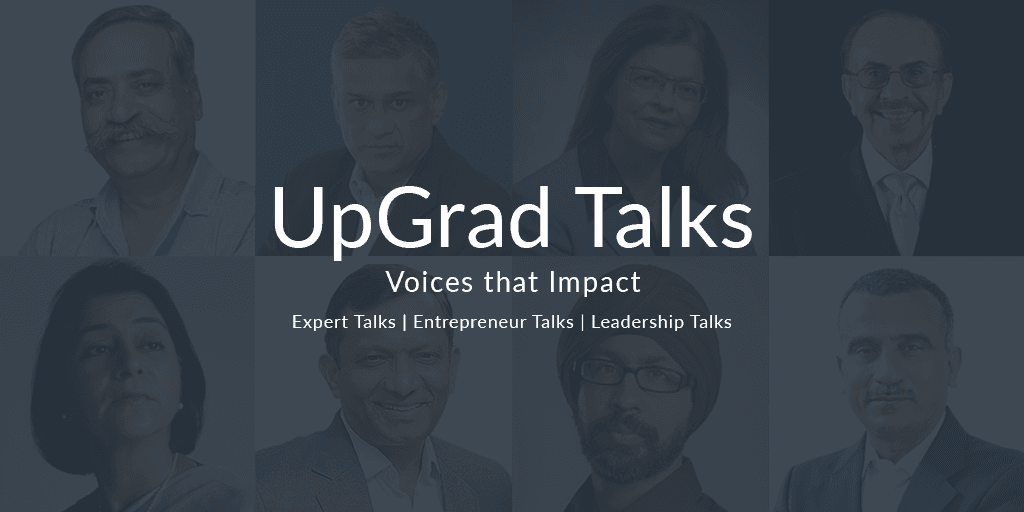There is really no secret sauce for success.
Provided you have had the opportunity to view the exclusive online tete-e-tete sessions brought to you by UpGrad Talks.
With an amazing roster of world-class speakers, some from the top 1000 companies of India such as Mahindra & Mahindra, Tata Sky, Coca Cola, JP Morgan, JWT to start-up poster children such as RedBus, Snadeal, Ola & Zivame and many more, Upgrad Talks provides insights into their formulae for success. The talks also share deep learning from situations that didn’t work out and many valuable nuggets of honest, down-to-earth and practical advice from successful entrepreneurs, experts and industry leaders.
While some lip service has been paid to new-age technologies and skill sets, and the evolution of industries because of these, a deeper understanding of what this signifies is missing. Upgrad Talks intends to fill this gap by bringing together thought-leaders from different walks of life and raising the level of discourse in this area, as they share their experiences.
Here are the top reasons why you must visit talks.upgrad.com today and make it your daily source of insights and motivation:
Get Inspired
Inspiration can come from many different sources.
You may get inspired when you see a problem that needs a solution, which you are able to ideate, or get inspired when you hear stories of adversity being overcome by sheer willpower. Rarely does the simple existence of wealth inspire us. It may motivate us to work harder, but inspiration stems from a deeper place that needs real stories. Upgrad Talks are stories from the folks who have lived these stories, first hand.
Not only does hearing someone’s complete story of challenges, thought process and subsequent outcome inspire, it also gives birth to new ideas and provides impetus to grow in your own space. Moreover, inspiration also stems from well-put statements such as, ‘attitude will sail you through,’ by Harit Nagpal, CEO of Tata Sky.
A key benefit of listening to industry leaders is that it also inspires us to think. ‘What we think, we become,’ is a quote by Buddha that sums up this well.
Go ahead, face challenges
It does not matter if you are a startup or an established financial organization; challenges, big or small, exist in every level of most businesses. Challenges faced, strategized and overcome is the rite of passage for almost everyone. Not only do Upgrad Talks cover challenges faced by leading industry veterans, it also covers it from various stages of businesses along with discussion of the solutions that helped overcome them.
Upgrad Talks speakers’ discuss challenges faced by businesses in different spaces, which makes these talks an interesting listen. Furthermore, is quite motivating to hear the candid conversations of business leaders.
So what is the common thought on challenges in the Upgrad Talks?
No challenge is too big. It also strengthens the belief that challenges help you grow and become stronger and develops a sense of confidence to take on the next big challenge.
Learn from influencers
People who can motivate are great influencers.
To hear success stories at Upgrad Talks, which have been driven by deep-rooted passion as well as courage of conviction can be a great influence on most people. It is likely to help you push yourself to greater heights and also follow your dreams a bit more diligently. To quote Snapdeal’s Kunal Bahl, ‘ there is a fine line between stubbornness and persistence.’
Upgrad Talks is likely to help you define the lines as an excellent selection of influencers talk also about the key soft skills required to make it a significant mark on the industry that you belong to.
Mentoring
As you listen to entrepreneurs, business leaders and experts on models that have worked, one can also start drawing parallels to one’s one business or profession. Mentoring of this kind is both subtle and effective as it helps you choose some key takeaways from the shared experiences that are most relevant to you.
Follow the series to get premium access to the best mentors in the country as they talk about education, the emerging digital age and its impact on businesses, talent shortages and advice to youngsters.
A bit of crystal gazing
In the series of Upgrad Talks, one is likely to come across a vast amount of business knowledge which has been converted into digestible insights that can also help you choose the next steps in your career.
Speakers’ at Upgrad Talks share their business mantras and what the future is likely to be. This is crystal gazing of the finest variety and yet another reason to tune into the talks.
A healthy dash of optimism
One of the unique selling points of the Upgrad Talks is that they also brings out the combined optimism in business from key industry leaders. Apart from that one can learn what is next in the industry, and explore potential future opportunities in the workspace. The upbeat and positive nature of these talks makes them a must-listen.
Easily available online
Just in case you were wondering how far you would need to travel to listen to such a wide range of speakers, you can breath easy. Upgrad Talks are delivered online and you can listen to them at your own convenience. All you need to do is to long onto talks.upgrad.com and you can access high quality, pre-recorded sessions online.
Upgrad is making content richer, bigger and better as it kicks off with 15+ talks delivered by entrepreneurs, experts & business leaders. You definitely do not want to miss out on the educational transformation that UpGrad is fuelling in partnership with some of the greatest minds. Remember, one can never stop learning.
So, if you always aspired to hear great advice and insights from the top Indian business leaders on how you can grow your business, choose a career goal or get inspired, do take a look at Upgrad Talks.
They are truly the voices that impact.
Join us today and be a part of it at talks.upgrad.com.
Omkar Pradhan
Blog AuthorOmkar Pradhan is part of HR Team at UpGrad, He majorly takes care of Talent Acquisition across the various functions here, along with the same, He is also responsible for Campus Hiring, Omkar comes with approximately 3.5 years of Rich Recruitment Experience which is across various industries. Omkar is absolutely passionate about Talent Acquisition.

























![Top 15 Highest Paying Non-IT Jobs in India [2024]](/__khugblog-next/image/?url=https%3A%2F%2Fd14b9ctw0m6fid.cloudfront.net%2Fugblog%2Fwp-content%2Fuploads%2F2020%2F08%2F936-Highest-Paying-Non-IT-Jobs-in-India.png&w=3840&q=75)
![Top 15 Trending Online Courses in 2024 [For Both Students & Working Professionals]](/__khugblog-next/image/?url=https%3A%2F%2Fd14b9ctw0m6fid.cloudfront.net%2Fugblog%2Fwp-content%2Fuploads%2F2019%2F07%2FBlog_FI_July_upGrads-Career-advice.png&w=3840&q=75)
![10 Best Job-Oriented Short Term Courses Which are In-Demand [updated 2024]](/__khugblog-next/image/?url=https%3A%2F%2Fd14b9ctw0m6fid.cloudfront.net%2Fugblog%2Fwp-content%2Fuploads%2F2019%2F12%2F111-banner.png&w=3840&q=75)
![Top 25 Highest Paying Jobs in the World in 2024 [A Complete Guide]](/__khugblog-next/image/?url=https%3A%2F%2Fd14b9ctw0m6fid.cloudfront.net%2Fugblog%2Fwp-content%2Fuploads%2F2021%2F06%2F04134425%2F2112.png&w=3840&q=75)
![Top 5 Highest Paying Freelancing Jobs in India [For Freshers & Experienced]](/__khugblog-next/image/?url=https%3A%2F%2Fd14b9ctw0m6fid.cloudfront.net%2Fugblog%2Fwp-content%2Fuploads%2F2020%2F12%2F1394.png&w=3840&q=75)

![Top 25 Highest Paying Jobs in India [2024] – Latest & Trending](/__khugblog-next/image/?url=https%3A%2F%2Fd14b9ctw0m6fid.cloudfront.net%2Fugblog%2Fwp-content%2Fuploads%2F2020%2F05%2FTop-10-Highest-Paying-Jobs-in-India.png&w=3840&q=75)
![Top 8 Highest Paying Jobs in India in Arts Field [A Complete Report]](/__khugblog-next/image/?url=https%3A%2F%2Fd14b9ctw0m6fid.cloudfront.net%2Fugblog%2Fwp-content%2Fuploads%2F2020%2F08%2F893.png&w=3840&q=75)
![Top 7 Jobs in Demand in 2024 [And How to Prepare Yourself?]](/__khugblog-next/image/?url=https%3A%2F%2Fd14b9ctw0m6fid.cloudfront.net%2Fugblog%2Fwp-content%2Fuploads%2F2019%2F07%2FBlog_FI_July_upGrads-Knowledge-base.png&w=3840&q=75)